
Spring in Holland: instantly it brings to mind images of blooming blocks of bold pinks and reds, whites and purples—fields of tulips as far as the eye can see. These fabulous preconceptions we have are not so fantastical: such images do exist. However, spring in Holland is also more real than this idea we have of tones swirling and blending together in a phantasm of color. Tulips are everywhere in spring—in parks, on corners, planted in pots and hidden in secret gardens—and though this may not be the 17th century, they are people’s livelihoods, cut and sold to the rest of the world, which demands the bit of spring the tulips are and bring.
For six weeks every year, all of Amsterdam comes together for the “Tulp,” or Tulip, Festival, a celebration of Holland’s famed flower. This year, the festival took place from April 1 to May 14; I planned my visit to Holland so as to arrive in the middle, in mid-April. Select shops and museums sell maps that show where tulips may be found throughout various parts of the city, including Centrum (Central), Noord (North), Zuid (South), and Oost (East), the most tulips being in the city center; I picked up my map for a euro at the Tulip Museum, where I began my tulip tour.
The Tulip Museum is small but a good place to spend half an hour or so. It tells the history of tulips in Holland, how they came to Holland and rose in status to such an extent as to cause Tulip Mania, nothing with which most people aren’t already somewhat familiar. One room, however, shows the steps of harvesting tulips, and in another, interactive touch screens display the name and a picture of different varieties of tulips when you touch numbers scattered throughout Europe and Asia. In the gift shop are beautiful amaryllises, the prettiest, I think, the Amaryllis charisma—pomegranate red in perfect lines radiating from the center, transparent where the color doesn’t quite reach some of the petals’ edges, and trimmed in a thin line of the same red, as if the flower were sketched on white organza.

Of the many tulip locations, including Damrak, the square across from the Royal Palace, Amstel Hotel, and the EYE Film Institute (a recently opened, architecturally modern cinematography museum that also screens films), those where I found the most remarkable tulips were Museumplein and Vondelpark. In Museumplein, in front of the Rijksmuseum and I amsterdam letters, is a long, rectangular pond stretching towards the other side of the park in and around which were big pots planted with tulips—purple tulips that caught the light, baby pink tulips, and more decidedly pink tulips that looked as though they’d been swept with a highlighter brush. Schoolkids had planted tulips of many colors that were in full bloom around the statue in Vondelpark.

Less conspicuous but worth searching for were those in the so-called “secret garden” of the hotel Andaz Amsterdam. The tulips themselves, of the “White Dream” variety, had actually for the most part either already or not yet bloomed, but the garden—Alice’s garden, the one to which the door is always locked in Carroll’s story—more than made up for the scarcity of the flowers. A black and white wall in the back shows Alice in Amsterdam in her light blue dress, holding an oversized navy spoon and surrounded by a rabbit, windmill, and of course, tulips! A hedge is kept trimmed to look like the mouse, while a watch face stands to the side. The floor is patterned as a chess board.

My final day in Amsterdam, I cycled through flower fields along “Bollenstreek,” known as the Flower Strip or Flower Route, in what was easily the highlight of my stay in Amsterdam. “Bollenstreek” stretches from Haarlem to Leiden, and as the train tracks parallel the length of it, it’s possible to rent a bike in Amsterdam, bike south until you feel tired, and hop on a train to go back. Having taken the train up from Rotterdam, though, and already seen the fields of red, pink, and yellow from afar, I opted to catch a train to Schipol Airport, from which buses to Keukenhof, manicured gardens to which tourists from all over the world flock during the two months of the year in which they’re open, depart every ten minutes. The gardens are located in Lisse, between Haarlem and Leiden, and while the gardens’ theme this year was “Dutch Design” and I’m positive they would have been beautiful, it was the tulips in nature that I wanted to see, so I avoided the Disneyland crowds and rented a bike in the parking lot for €10.
Four bike paths encircle the gardens. As soon as I exited the parking lot, I went the wrong way, taking Route 4 to the additional fields, on the wrong side of the road for taking pictures. When I realized this, I turned around and soon found myself on Route 3 and in Halfweg, where I thought were the most fully blossoming tulips of all of the tulips I saw that day (and I saw them at the beginning!). To the far left were light red ones like the tips of flames, their petals confused as to whether they were supposed to be red or pink. Closer to me were dark pink tulips, slightly more sparse but brilliant in color, and across a small river were tulips of the same and a lighter color, growing in luxuriant rows.


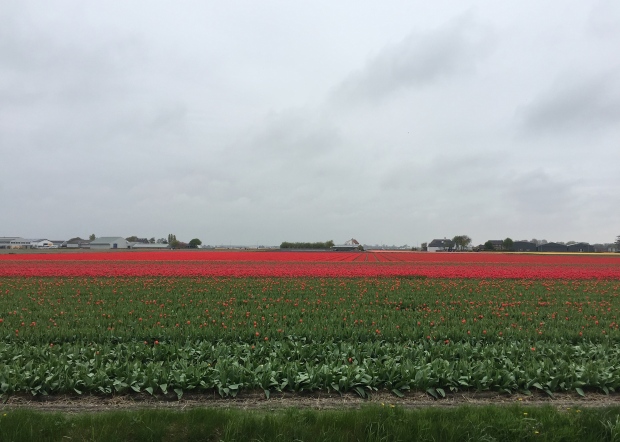
Farther on, the bike path led past a lake, which wasn’t flower fields but was nice nonetheless, giving to the route a sense of serenity and a good deal of green. On the other side of the lake, the path turned onto a road on either side of which were working fields. Workers picked tulips in one; another was filled with pink striated tulips; another with red, purple, orange, and yellow ones, and beyond that, light and dark pink ones; another with red, white, and yellow.
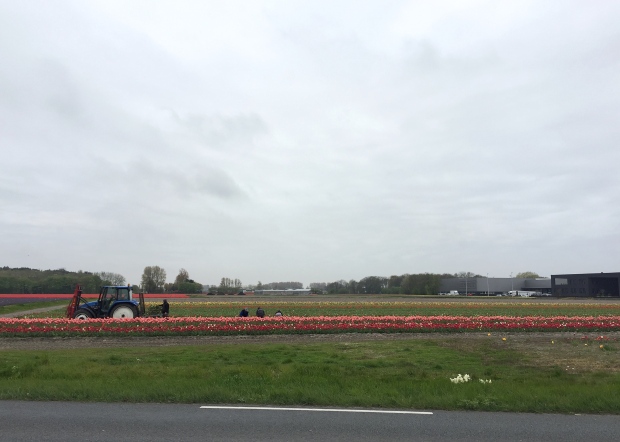

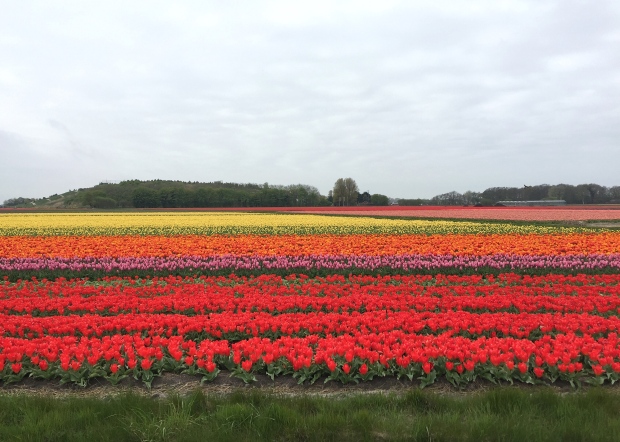
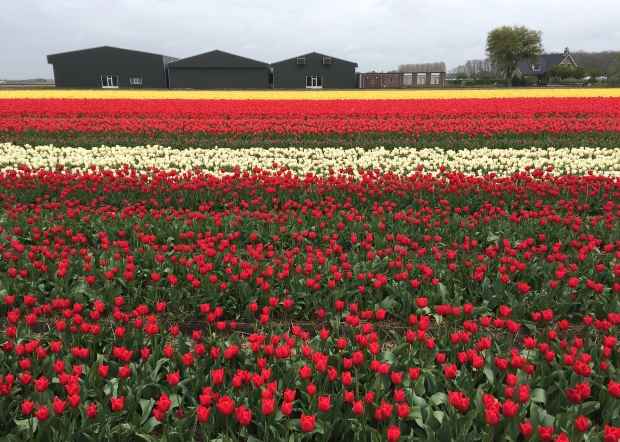
At the end of the road, I cut across from Route 3, which continued on towards the ocean, to Route 2, to see more tulips. On this route I saw fields that looked as though their flowers had been recently cut, crushed pink petals littering the spaces between rows. but biking around a bend onto the first of them, I thought even this sight lovely. Many of the fields I saw were less full of tulips than I had imagined, but this is why the tulips in Holland are “real”: they are cut and sold, not grown to simply sit there and look pretty.
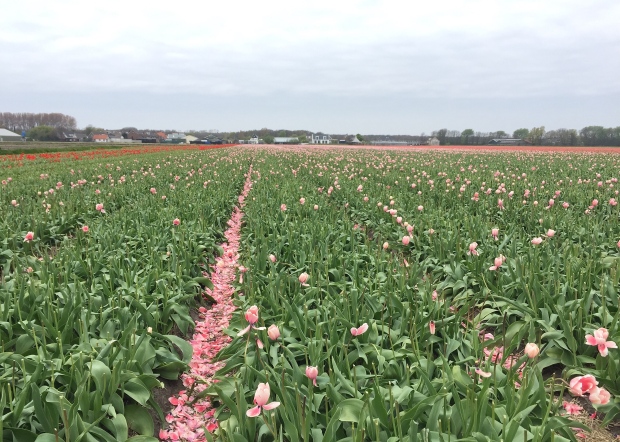

I didn’t expect to see so many hyacinths, either. My favorites were a whole plot of baby pink ones and another of deep purples.



Finally stopping for lunch, I watched a woman get out of the car where her husband waited and carefully make her way down the hill from the road to be closer to the tulips. These fields were messy but gorgeous—all yellow diamonds, red satin, ballerina slippers, lavender kisses, and fresh cream. After the woman had left, I made my own way down the hill and disappeared into the tulips.

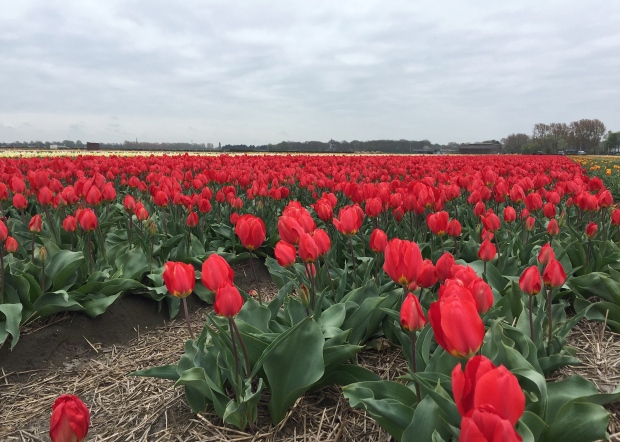
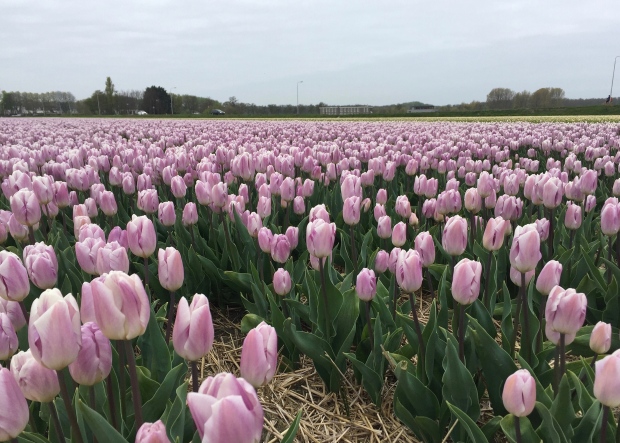
What colors! Must have been quite amazing to see.
LikeLike